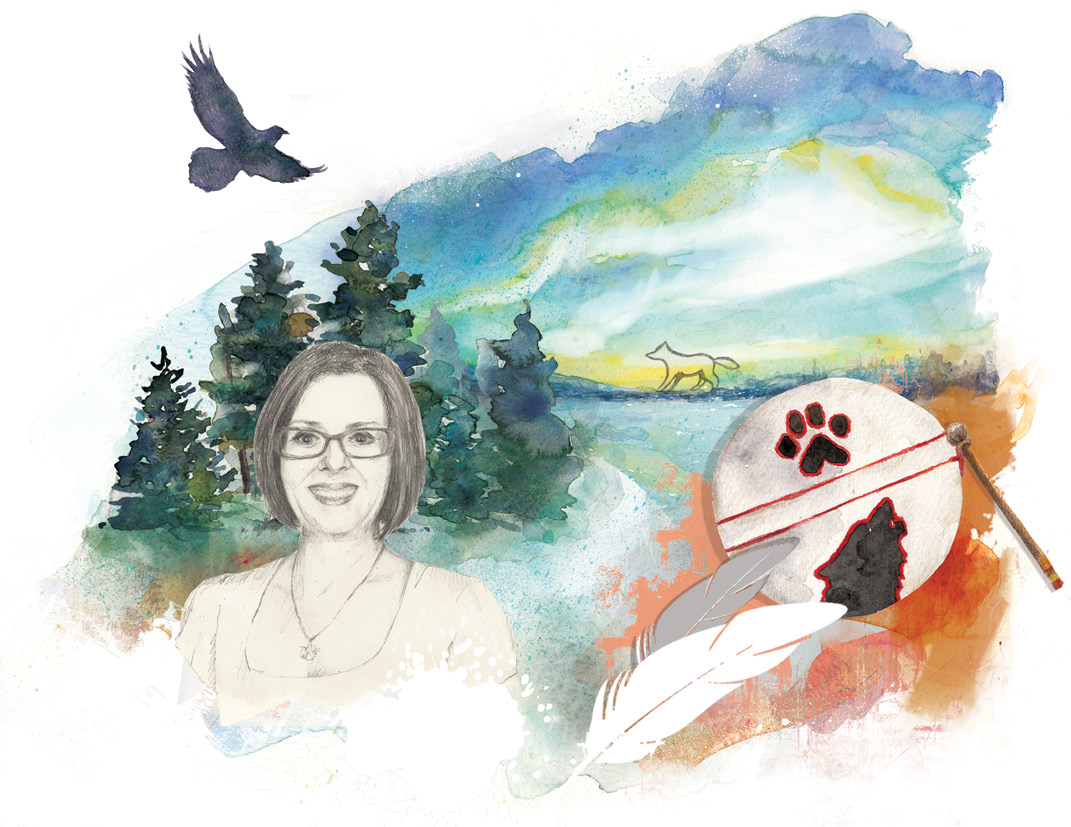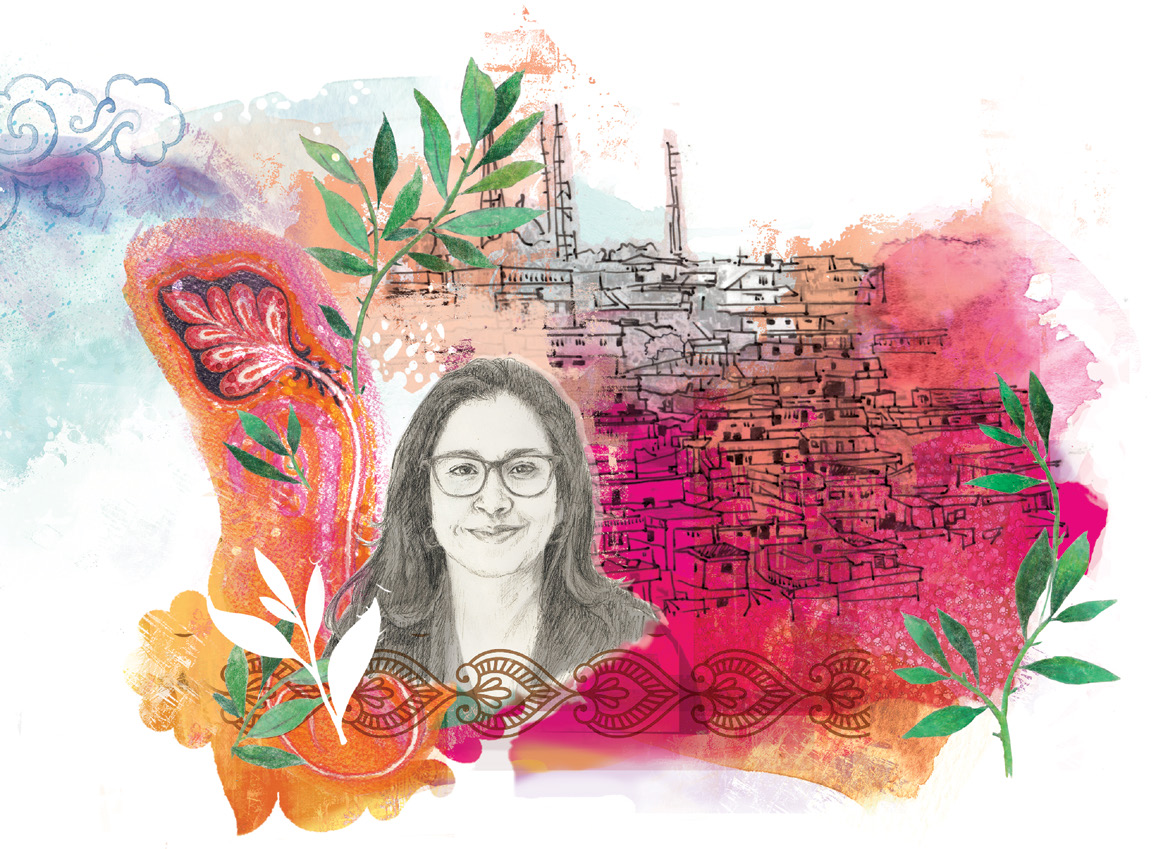Share this page
By Stuart Foxman
Illustrations: Janice Kun/i2i Art

Many OCTs choose to teach in remote or far-off locations, from fly-in communities in the North to the other side of the world. How have these experiences shaped them, and what best practices can teachers learn from them?
Diana Yalowica, Yukon
Talk about a room with a view. When Diana Yalowica, OCT, gazes out her living room window, she can see the Northern Lights. “Amazing,” she says.
For two years she has taught at the Ross River School, in an Indigenous community of less than 400 about five hours northeast of Whitehorse. The local amenities include a general store (also the bank and post office), gas, nursing and RCMP stations, a community centre and the school.
Yalowica started her career as an early childhood educator in southern Ontario, before pursuing her B.Ed. She did supply teaching in Ontario, then worked at an international school in Shanghai. Back in Canada, full-time jobs were so scarce that she considered leaving the profession. Then her husband saw job postings for the Yukon and encouraged her to apply.
Her K to 12 school has around 50 students. Half the time she teaches the biggest class, 10 JK/SK students, and in the other half she does reading recovery. Ross River follows the B.C. curriculum, with a strong focus on incorporating Indigenous culture.
“We welcome elders into our school, and the children participate in activities such as oral storytelling and traditional crafts,” says Yalowica. “A focus is also on preserving First Nations languages. We work on integrating keywords into daily practice in each classroom.”
Her one-year post turned into a second year, and now she’d like to stay long term. She learned that in a small school you must fill many roles. While there aren’t any specialty teachers, everyone has their area of expertise, “so we brainstorm together,” she says. “Sharing each other’s strengths is important.”
Yalowica says some lessons from teaching in Shanghai, where she had to be sensitive to students who came from around the world, apply in her current role. “It made me more understanding. This has carried with me in the Yukon. Although we live in Canada, the First Nations ways of knowing and doing can be very different. I need to be aware, respectful and sensitive to that.”

Tim Gernstein, Taiwan and China
Tim Gernstein, OCT, has taught in Ontario for almost his entire career. Yet three job experiences far from home — two summers in Taipei and Beijing, and his first teaching job in northern Manitoba — have made a considerable impact.
Gernstein is an elementary teacher (Grade 5/6 split) for the York Region District School Board. In 2015 and 2017 he participated in Summer Teach Abroad, where teachers gain professional experience in a different culture and educational context.
In Taiwan and China, Gernstein was aware of being “the other.” It reminded him that all students can perceive themselves that way sometimes, because of their background, interests or just who they are.
“People can feel like they’re one of a few,” he says. “I make my activities as inclusive as possible, with multiple entry points. Everyone has a way in, regardless of abilities.”
Gernstein says the students abroad were excited to learn from the Western way of teaching. He has spent most of his career with primary students, where that comes naturally. Teaching older students in Taipei and Beijing (some in Grades 7 to 8) reinforced that all students want education to be imaginative. “You’re learning and not realizing it,” he says, “because you’re having so much fun.”
Even more indelible was his experience teaching in Granville Lake, Man., about 2½ hours north of Thompson. He took the job when there were no openings in the Toronto area. Gernstein will never forget the sight of the local “bus,” which was a parent driving a snowmobile pulling a sled carrying a dozen children.
This was isolation — a community of about 75 and a school of 20, nowhere to go and little to do. In off hours, Gernstein spent a lot of time reading and writing, or playing Scrabble with the other teacher, a retired nun.
“That first experience still colours much of my career,” he says. “I had to be flexible. I didn’t have the luxury of running out to pick up supplies. I had to use whatever we had.”
Those lessons endure. “In class, if something isn’t going the way I want it, that’s OK. I can adapt to make it work. Use what you have at your disposal if you have an idea. It taught me to be resourceful.”

Melissa Fernandes, India
Work never seems to quite end for Melissa Fernandes, OCT. She teaches language arts and literature to Grades 3 and 4 at Good Shepherd International School, a boarding school in Ooty, India.
Fernandes lives on campus. After school hours, there’s games time for the children and homework prep. Fernandes also sits alongside the children in the dining hall for all meals. Besides her classroom work, she’s a mentor to five students and meets them twice weekly. As part of the school’s house system, Fernandes also prepares students for elocution and poetry recitation competitions. Her days typically last from 8 a.m. to 8 p.m., though some days can end at 9:30 p.m.
Though the schedule is gruelling, Fernandes is grateful for such a unique experience for her first teaching assignment.
For 15 years, she was an advertising account manager in Toronto. At different points, she volunteered as a tutor and also with organizations connected to education, such as one catering to at-risk youth. When she decided to study teaching, she had a three-week alternate practicum at an International Baccalaureate (IB) school in Bangalore, India. Fernandes was intrigued by the idea of teaching abroad to start her second career.
Ooty is a small town of 88,000 in Tamil Nadu. While the market is bustling, the area surrounding the school is quiet. Much nearby land is used for growing crops (carrots, cabbages) and for tea plantations.
Despite hectic days, Fernandes says, “I’m learning to be more patient with myself — not overly pushy, which is the way I operated in Toronto with my advertising background. Now I’m learning to take everything in stride.” She gives some credit to the serene surroundings and some she sees as the calming nature of South Indian culture.
Fernandes' broad role has also revealed something about her mission. “I under-stood teaching as a vocation and commitment,” she says. “Through the duties at the school, I’ve experienced the service aspect. This experience has been an opportunity to really participate in the students’ personal and academic growth holistically, as well as my own development in teaching.”

Natalie Pitre, China
Natalie Pitre, OCT, didn’t have the opportunity to travel as a child. She has more than made up for it.
Pitre has taught in Japan, Egypt, Switzerland and the United Arab Emirates (UAE). Her husband, Jason Palmer, OCT, also taught in the UAE, their first time working together overseas. Now they’re both in Shanghai working for the Dipont Education Management Group, a Chinese educational services company
In Canada both had worked for the Upper Canada District School Board, Pitre as an ESL resource teacher and Palmer as a teacher, department leader, vice-principal and principal (he’s now on a leave of absence from the board). Most recently, Pitre taught part-time as an adjunct assistant professor in the faculty of education at Queen’s (she still teaches online courses), following the completion of her doctorate in Educational Leadership K-12 from the University of Calgary.
Dipont Education Management Group focuses on the delivery of international curricula and educational enrichment programs for Chinese students, including Advanced Placement (AP), A-Level Cambridge International Examinations and International Baccalaureate programs.
Pitre is the deputy director for Chinese teacher training. She leads a team designing an enhanced version of the Chinese National Curriculum in English for Grades 1 to 6, for two new campuses that Dipont will open this September offering international programming for expatriates.
The Ontario Certified Teacher is also leading the team to design a bilingual teacher training program.
Palmer is a deputy director for academics, overseeing AP and IB centres in Beijing.
To Pitre, teaching throughout the world has reinforced the value of developing intercultural competence.
“Regardless of where I teach and lead, it’s important to be culturally responsive and develop a deep knowledge of students to build a sense of community,” she says.
The exposure to different environments has helped her to remain open, no matter where she has taught.
“I’ve found that kids are often open to trying new ways of learning if the teacher is open to learning from her students,” Pitre explains.
“Whether I teach in Ontario or anywhere else in the world, I’m always a learner first. I expect my students to be the same.”

Richard Llanera, Northern Ont.
After teaching in his native Philippines for 12 years, Richard Llanera, OCT, moved to Toronto in 2015 to start a new life. His wife preceded him to the city, and he was eager to get his Ontario teaching credentials. Until then, he landed a job as a clerk in a bank mailroom.
When he was certified in 2017 he applied for teaching positions without success. So Llanera kept expanding his search — including (much) farther north. He ended up with a one-year contract later that year teaching Grades 7 and 8 at Native Sena School in North Caribou Lake, Ont., 320 kilometres north of Sioux Lookout.
Llanera realized that he needed to expand his own horizons. Besides teaching general studies, he had to help with Special Education, where he had no training. His first week, Llanera signed up for online courses to get ideas on how to deal with diverse learning needs.
As a new local, Llanera was open to all sorts of experiences, from moose meat to ice fishing. He felt it was important to not just learn about the culture but to integrate it into his teaching. For instance, the process of using a mechanical drill and making a hole in ice can be a valuable science lesson. “You need to be creative,” he says.
Teaching in a remote community means becoming comfortable with change, says Llanera. He had to get used to performing double duties, teaching a split class, being away from his family (his wife, child and another on the way) and fitting into a very different community from Toronto or Manila.
Llanera feels that he has honed his professional skills in Canada, and his ability to respond to new situations.
“In any classroom, you face different kinds of students. You need to understand and adjust with them.”
What’s the most rewarding aspect or educational advantage of teaching in far-off places? Four more teachers weigh in.